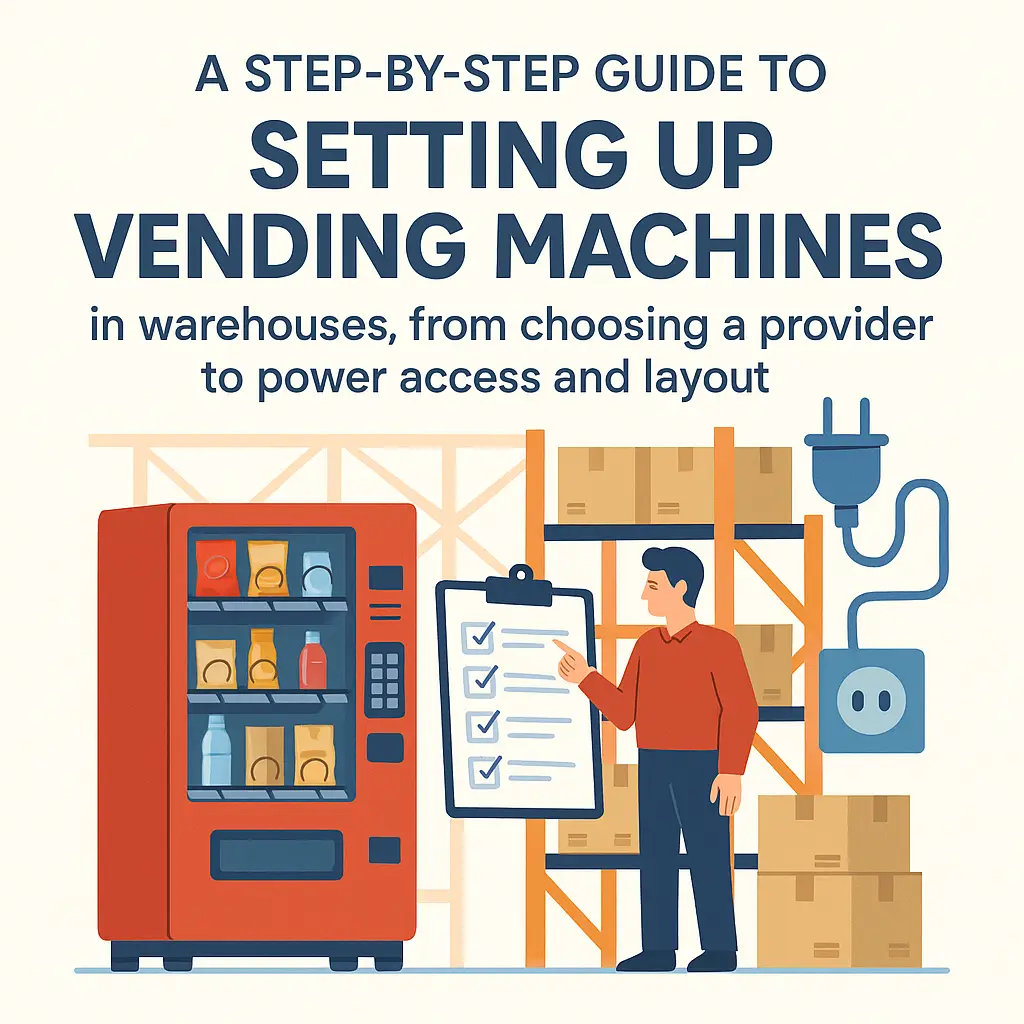How to Install Vending in Your Warehouse
A step-by-step guide to setting up vending machines in warehouses, from choosing a provider to power access and layout.
Back to Vending for Warehouses ResourcesA step-by-step guide to setting up vending machines in warehouses, from choosing a provider to power access and layout.
Back to Vending for Warehouses ResourcesWarehouse vending installations require a designated space, access to standard electrical outlets, and clear communication with the vendor. Layout and breakroom visibility also affect machine type and usage. Learn how the right setup supports employee convenience and inventory uptime.
![]() Install vending within 7 days at qualified warehouse locations
Install vending within 7 days at qualified warehouse locations
![]() Glass-front machines work well in high-traffic warehouse areas
Glass-front machines work well in high-traffic warehouse areas
![]() Smart vending tech allows restocking based on real-time data
Smart vending tech allows restocking based on real-time data

Installing vending machines in a warehouse comes with a unique set of logistical and practical considerations. Unlike traditional office spaces, warehouses often have fewer designated break areas and more demanding shift schedules. That’s why planning the right placement, machine type, and provider is critical to a successful vending setup.
Start by identifying a designated high-traffic zone for the machines—typically near a breakroom or time clock. This ensures visibility and convenience for employees without disrupting workflow. Measure the space to accommodate vending equipment: combo machines often require 3 to 5 feet width, while AI coolers and micro markets need more room and power access.
You’ll also need to verify sufficient electrical capacity. Most vending machines use standard 120V outlets, but micro markets and smart coolers may require additional power or internet connectivity. Communicate this early with your vending provider to avoid delays in setup.
Next, choose the right machine for your warehouse team. Combo snack + drink units offer convenience for shift workers who need hydration and quick calories. AI coolers and glass-front machines provide high visibility for stocked products and accommodate modern payment systems—something today’s employees expect. If your staff works long or overnight hours, consider 24/7 access and machines with shelf-stable meals and energy options.
Once you’ve chosen a provider, the typical warehouse installation takes 5 to 7 business days. This includes delivery, stocking, equipment setup, and testing payment functionality. If you're replacing an outdated vendor due to service issues, ensure your new provider offers restocking alerts and machine uptime guarantees as part of their plan.
Don’t overlook vendor reputation. Warehouses often face issues like broken machines, slow restocks, or expired products. Working with a trusted vending partner or managed service platform minimizes those risks.
For insights into cost structures in other business types, you can explore average vending service pricing for apartments or review machine choices in a legal office environment.
If you're exploring vending options for your business, Vending Exchange can help simplify the process. Delivery, Installation and Equipment is provided at no cost to you - vendors provide the machines, keep them stocked, and handle all servicing. Whether you need a provider or full-service management, just fill out the form on this page to get started.
Most installations are completed within 5 to 7 business days after selecting a provider and finalizing space details.
Most machines only require a standard 120V outlet, but smart fridges or markets may need additional power or network access.
Place machines in visible, high-traffic areas near breakrooms, time clocks or locker zones for easy employee access.
Combo machines or glass-front vending units are ideal for warehouses due to their variety, visibility, and durability.
Yes, many vendors offer shelf-stable meals and healthy snacks, especially for facilities with multiple worker shifts.
Work with providers who offer maintenance support, restocking alerts, and machine uptime monitoring to avoid service gaps.
Only smart tech machines, such as AI coolers or micro markets, need an internet connection to enable real-time features.
If the location qualifies, vendors typically provide installation, equipment, and service at no cost to the business.
Yes, vending machines are designed for 24-hour use and support around-the-clock access in most warehouse environments.
Using a referral service like Vending Exchange helps match you with vetted local providers who specialize in warehouse setups.